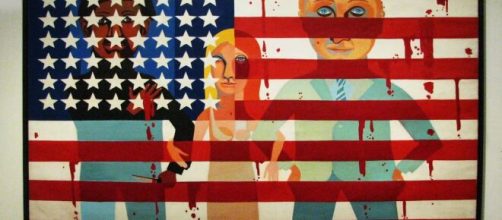When the American flag gets into picture-making, it can take on more meaning than patriotism. Consider George C. Scott in the opening scene of the 1970 movie “Patton” bespangled in medals and ribbons as he stands in front of a super-size Stars and Stripes.
Playing the General, Scott gave a six-minute motivational speech to the green Third Army troops, spurring them on to do their duty regardless of personal fear. The Star-Spangled Banner, in this instance, was a symbol of militarism and the glory of warring.
Now comes news about a flag of a different stripe.
The National Gallery of Art has just purchased Ringgold’s painting "The Flag is Bleeding," made in 1967. The title tips you off that there’s no glory in Old Glory.
Art Daily quotes Harry Cooper, senior curator at the National Gallery, saying, “This may well be the most important purchase of a single work of contemporary art since the National Gallery acquired Jackson Pollock’s Lavender Mist in 1976.”
Drip painting of a second kind
What you see in "The Flag is Bleeding" is blood dripping from the red stripes in Old Glory. The stripes stand as prison bars restraining three figures – a Black man, a white woman, and a white man. Wait, there’s more.
There’s a knife in the Black man’s one hand while his other hand staunches bleeding from a wound in his heart.
Or is he pledging allegiance? Also notable: while the white man wears a suit and tie, the black man is in a turtleneck sweater. The only thing missing from his outfit is a bank robber’s mask.
Ringgold, who is Black, now 91 years old, commented on "The Flag is Bleeding" when it showed recently at the Glenstone Museum in Potomac, MD. Quoted by CultureTypes, she said: “We thought of the American flag as our symbol of freedom, but we were losing our freedom in the ‘60s,” a reference to the race riots at that time. “The flag was bleeding, and it may still be,” she added.
Curator Cooper told Art News in an interview: “We at the National Gallery are trying more and more to represent the paintings that have something important to say about the nation.”
Speaking up
Ringgold has been having “something important to say” for nearly 50 years, and it’s not always about race.
In a painting she made during the Vietnam War, she pictured a war-weary America in the worn face of a Gold Star mother and something more.
There’s always something more in Ringgold’s work, particularly regarding her use of the Stars and Stripes. In her image of the Gold Star mother, she shows the woman partially hidden by the stripes in the flag, staring out between them as if they are prison bars.
While wrapping oneself in the flag usually means making a show of one’s patriotism, Ringgold does it to illustrate her take on the American experience.
NOTE: A retrospective of Ringgold’s work is planned at the New Museum in NY from February 17 through to June 5, 2022.


